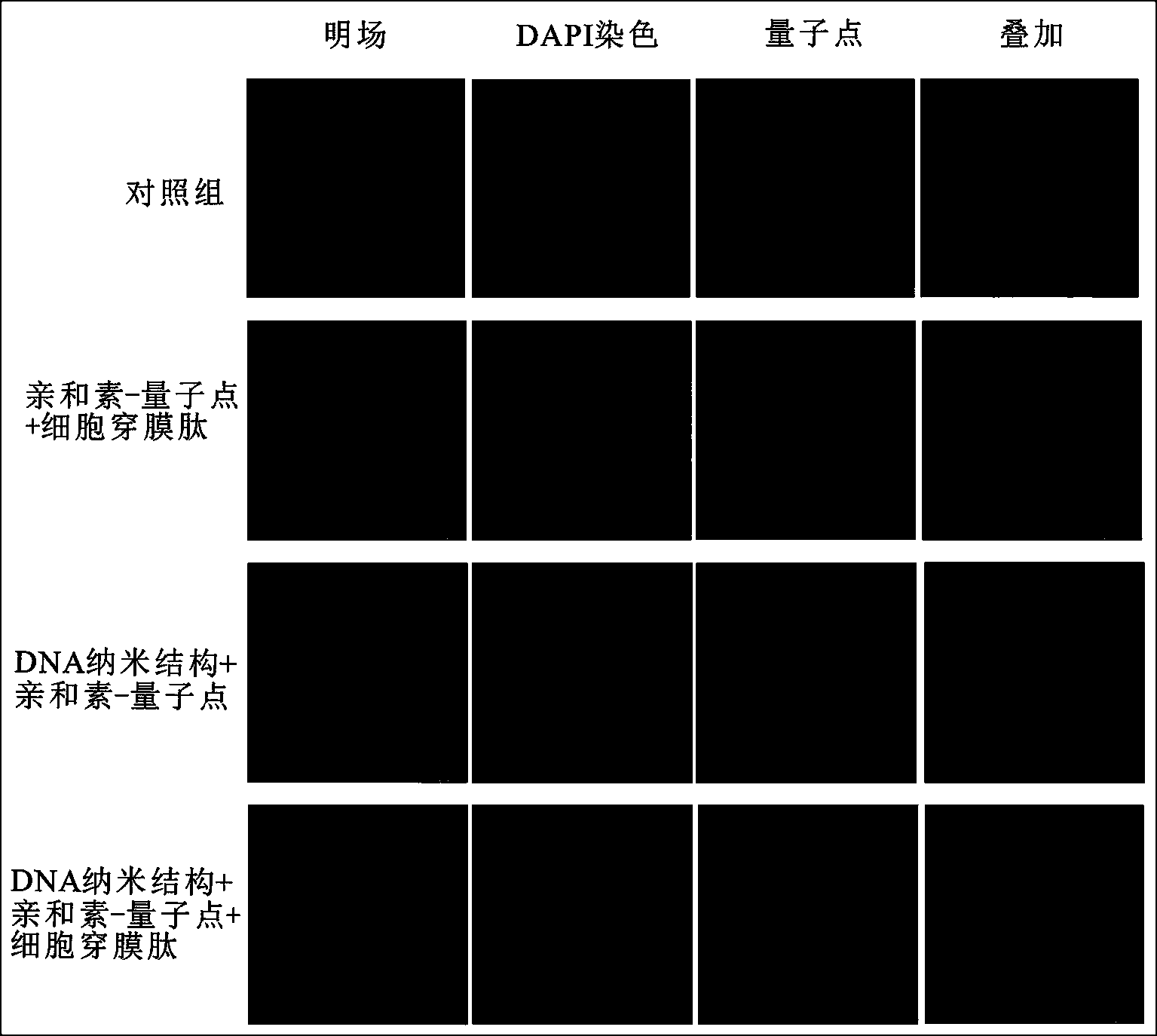Method for using polypeptide-mediated DNA nanostructure as antitumor drug carrier
A technology of anti-tumor drugs and nanostructures, applied in anti-tumor drugs, drug combinations, pharmaceutical formulations, etc., can solve the biosafety disputes of metal nanoparticles, affect the efficiency of carriers entering cells, etc., and achieve the effect of improving loading efficiency
- Summary
- Abstract
- Description
- Claims
- Application Information
AI Technical Summary
Problems solved by technology
Method used
Image
Examples
Embodiment 1
[0025] Add 12 μL of circular DNA (2 μM, sequence: 5'TATGCCCAGCCCTGTAAGATGAAGATAGCGCACAATGGTCGGATTCTCAACTCGTATTCTCAACTCGTATTCTCAACTCGTCCTGCCCTμL, 10 mM) to 16 μL primer DNA (1 μM, sequence: 5'CCAGCCTAAGAGTTGAGCA3'), dNTPs (4 μL, 10 mM), RCA buffer polymerase 4μL, 10 U / μL), the final volume of the mixed solution was 40μL. Then 30°C, amplified in a water bath for 30min. 40 μL of the obtained product was subjected to 10% PAGE electrophoresis, and then recovered by slicing gel to remove small fragments of DNA, redundant circular DNA and primer DNA. Take 3 μL of the recovered product, add 12 μL of milliQ water, and add stapled strands 1-3 (100 μM, the sequence is as follows:
[0026] 5'-CAGCCCTGTAAGATGAAGATAGCGTCTATGCC-3'
[0027] 5'-CCCTGACTCACAATGGTCGGATTCCGTCTCTG-3'
[0028] 5’-TCTCAACTTCAACTCGTATTCTCAACTCGTAT-3’) 1 μL each, 2 μL TAE buffer (10×, 125 mM Mg 2+ ), the total volume was 20 μL, the solution was mixed well and placed in a high temperature of 95 °C, and then the tem...
Embodiment 2
[0030] Add 12 μL of circular DNA (2 μM, sequence: 5'TATGCCCAGCCCTGTAAGATGAAGATAGCGCACAATGGTCGGATTCTCAACTCGTATTCTCAACTCGTATTCTCAACTCGTCCTGCCCTμL, 10 mM) to 16 μL primer DNA (1 μM, sequence: 5'CCAGCCTAAGAGTTGAGCA3'), dNTPs (4 μL, 10 mM), RCA buffer polymerase 4μL, 10 U / μL), the final volume of the mixed solution was 40μL. Then it was amplified in a water bath at 30°C for 30 min. 40 μL of the obtained product was subjected to 10% PAGE electrophoresis, and then recovered by slicing gel to remove small fragments of DNA, redundant circular DNA and primer DNA. Take 3 μL of the recovered product, add 12 μL of milliQ water, and add stapled strands 1-3 (100 μM, the sequence is as follows:
[0031] 5'CAGCCCTGTAAGATGAAGATAGCGTCTATGCC3'
[0032] 5'CCCTGACTCACAATGGTCGGATTCCGTCTCTG3'
[0033] 5'TCTCAACTTCAACTCGTATTTCTCAACTCGTAT3', where the 5' of staple 2 is biotin-modified) 1 μL each, 2 μL TAE buffer (10×, 125 mM Mg 2+ ), the total volume was 20 μL, the solution was mixed well and place...
Embodiment 3
[0035]Add 12 μL of circular DNA (2 μM, sequence: 5'TATGCCCAGCCCTGTAAGATGAAGATAGCGCACAATGGTCGGATTCTCAACTCGTATTCTCAACTCGTATTCTCAACTCGTCCTGCCCTμL, 10 mM) to 16 μL primer DNA (1 μM, sequence: 5'CCAGCCTAAGAGTTGAGCA3'), dNTPs (4 μL, 10 mM), RCA buffer polymerase 4μL, 10 U / μL), the final volume of the mixed solution was 40μL. Then it was amplified in a water bath at 30°C for 30 min. 40 μL of the obtained product was subjected to 10% PAGE electrophoresis, and then recovered by slicing gel to remove small fragments of DNA, redundant circular DNA and primer DNA. Take 3 μL of the recovered product, add 12 μL of milliQ water, and add stapled strands 1-3 (100 μM, the sequence is as follows:
[0036] 5'CAGCCCTGTAAGATGAAGATAGCGTCTATGCC3'
[0037] 5'CCCTGACTCACAATGGTCGGATTCCGTCTCTG3'
[0038] 5'TCTCAACTTCAACTCGTATTTCTCAACTCGTAT3', where the 5' of staple 2 is biotin-modified) 1 μL each, 2 μL TAE buffer (10×, 125 mM Mg 2+ ), the total volume was 20 μL, the solution was mixed well and placed...
PUM
 Login to View More
Login to View More Abstract
Description
Claims
Application Information
 Login to View More
Login to View More - R&D
- Intellectual Property
- Life Sciences
- Materials
- Tech Scout
- Unparalleled Data Quality
- Higher Quality Content
- 60% Fewer Hallucinations
Browse by: Latest US Patents, China's latest patents, Technical Efficacy Thesaurus, Application Domain, Technology Topic, Popular Technical Reports.
© 2025 PatSnap. All rights reserved.Legal|Privacy policy|Modern Slavery Act Transparency Statement|Sitemap|About US| Contact US: help@patsnap.com

